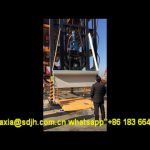Suspended platforms are known by several other terms, which can vary depending on the region and specific industry. Here are some alternative names for suspended platforms:
1. **Swing Stage**: This is a common term used particularly in the United States and Canada. It emphasizes the platform's ability to swing or hang while suspended by ropes or cables.
2. **Suspended Scaffold**: This term highlights the temporary scaffold aspect of the platform, which is suspended from above, similar to traditional scaffolding but with the flexibility of being movable vertically.
3. **Hanging Scaffold**: Similar to "suspended scaffold," this term is used to describe the scaffold that hangs from a structure above it.
4. **Cradle**: In the UK and some other parts of Europe, suspended platforms are often referred to as cradles, emphasizing the platform's role in cradling workers as they perform tasks at height.
5. **Suspended Swing Stage**: This term combines elements of "swing stage" and "suspended scaffold," providing a clear description of the platform's function and design.
6. **Suspended Work Platform**: A more descriptive term, it clearly indicates the platform’s purpose for facilitating work at elevated heights.
7. **Suspended Access Platform**: This term is sometimes used to emphasize the platform's role in providing access to otherwise inaccessible areas, particularly on building exteriors.
Each of these terms might be preferred in different contexts or regions, but they all refer to the same type of equipment used for safe and efficient work at heights.
http://www.scanclimber.com - Scanclimber offered a tailored industrial/permanent hoist SC1120 for NGK Ceramics factory combined with conveying rollers in order to reduce labor participation and manual transportation of goods. The main benefit of using Scanclimber hoist was an automatic line for horizontal and vertical goods transport.
In the INSTALLATION phase, a station for the hoist was established on every floor of the building. The hoist included a small roller table with the same height as conveyer rollers outside the hoist for material transportation. The gates of the hoist included automated sensors which made it open when hoist reached the floor so it could start rolling the material bags out to conveyer rollers directing them to production unit. The hoist’s vertical movement is along two mast sections on the sides in order to ensure smooth drive and long lasting stability.
AFTER IMPLEMENTATION of the Scanclimber hoists in NGK Ceramics factory, the laborsome activities were reduced to minimum for material handling. They were involved in transferring ceramic material bags to conveyer via lifting equipment and pressing the button of floor level on control panel of hoist. The hoist then transports the material to determined floor level. In this way, the possibility of any intense physical work was eliminated along with the unproductive movement of labor with the material.































